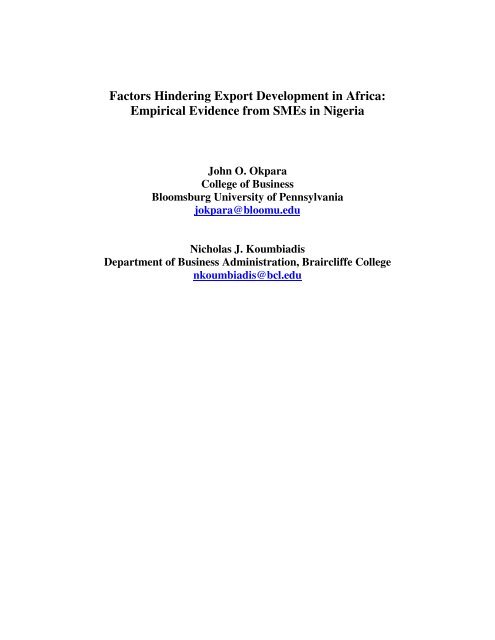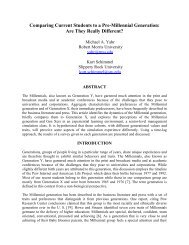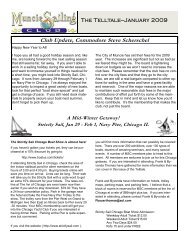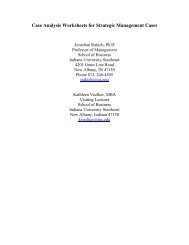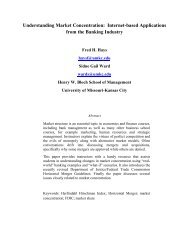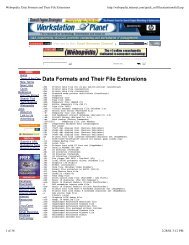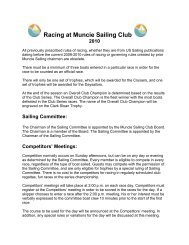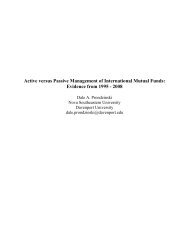Factors Hindering Export Development in Africa: Empirical Evidence ...
Factors Hindering Export Development in Africa: Empirical Evidence ...
Factors Hindering Export Development in Africa: Empirical Evidence ...
Create successful ePaper yourself
Turn your PDF publications into a flip-book with our unique Google optimized e-Paper software.
<strong>Factors</strong> <strong>H<strong>in</strong>der<strong>in</strong>g</strong> <strong>Export</strong> <strong>Development</strong> <strong>in</strong> <strong>Africa</strong>:<strong>Empirical</strong> <strong>Evidence</strong> from SMEs <strong>in</strong> NigeriaJohn O. OkparaCollege of Bus<strong>in</strong>essBloomsburg University of Pennsylvaniajokpara@bloomu.eduNicholas J. KoumbiadisDepartment of Bus<strong>in</strong>ess Adm<strong>in</strong>istration, Braircliffe Collegenkoumbiadis@bcl.edu
<strong>Factors</strong> <strong>H<strong>in</strong>der<strong>in</strong>g</strong> <strong>Export</strong> <strong>Development</strong> <strong>in</strong> <strong>Africa</strong>:<strong>Empirical</strong> <strong>Evidence</strong> from SMEs <strong>in</strong> NigeriaJohn O. OkparaCollege of Bus<strong>in</strong>essBloomsburg University of Pennsylvaniajokpara@bloomu.eduNicholas J. KoumbiadisDepartment of Bus<strong>in</strong>ess Adm<strong>in</strong>istration, Braircliffe Collegenkoumbiadis@bcl.eduABSTRACTExpansion of a nation’s exports has a significant positive effect on the growth of a nation’seconomy. <strong>Export</strong>s <strong>in</strong>crease productivity, provide employment, and improve trade balances. Inspite of the benefits result<strong>in</strong>g from export<strong>in</strong>g, for many small and medium sized (SMEs)manufacturers <strong>in</strong> Nigeria, the process of export<strong>in</strong>g is plagued with numerous problems. Thepurpose of this paper is to <strong>in</strong>vestigate the factors h<strong>in</strong>der<strong>in</strong>g export development of smallbus<strong>in</strong>esses <strong>in</strong> Nigeria. A survey method was used to collect data from small bus<strong>in</strong>esses located <strong>in</strong>selected cities <strong>in</strong> Nigeria. Several statistical analyses were conducted to identify<strong>in</strong>g the factorsh<strong>in</strong>der<strong>in</strong>g export development of SMEs. There are various obstacles fac<strong>in</strong>g SMEs who want toparticipate <strong>in</strong> export markets. These barriers <strong>in</strong>clude: lack of f<strong>in</strong>ance, lack of qualified personnel,fear of foreign competition, lack of productive capacity, poor <strong>in</strong>frastructure, corruption,bureaucracy, and general lack of knowledge on how to export. Theoretical and practicalimplications of the study are discussed.
INTRODUCTION<strong>Export</strong><strong>in</strong>g represents one of the major forms of <strong>in</strong>ternational <strong>in</strong>volvement for firms. This isprimarily because it does not absorb the resources which other forms entry strategies such jo<strong>in</strong>tventures and overseas operations generally demand and therefore, tends to be associated withless risk [18]. Many develop<strong>in</strong>g nations have identified export<strong>in</strong>g as a lead<strong>in</strong>g priority for their<strong>in</strong>digenous firms and several countries have developed export-oriented trade strategies andextensive assistance programs to encourage export expansion [16; 22].Small and medium-sized enterprises (SMEs) contribute to a country’s export around the worldSmall firms are becom<strong>in</strong>g <strong>in</strong>creas<strong>in</strong>gly <strong>in</strong>ternational <strong>in</strong> their operations; they also appear to beenter<strong>in</strong>g the <strong>in</strong>ternational market at an earlier age than had been the case <strong>in</strong> previous decades [2].Nevertheless exporters <strong>in</strong> sub-Saharan <strong>Africa</strong> are fac<strong>in</strong>g overwhelm<strong>in</strong>g challenges that limit theirability to realize growth opportunities. Most sub-Saharan <strong>Africa</strong> countries have recognized theimportance of exports as an eng<strong>in</strong>e for economic growth. A number of these countries havedeveloped policies and strategies for export expansion, but most do not have a policy for smallbus<strong>in</strong>ess. Given the scarcity of resources for overall export promotion, and reluctance to allocatemore funds for export development may be due to a lack of ability to target those firms that havea high potential to succeed [7] or those that may be motivated to export. Therefore, there is aneed for more research to identify and target segments with<strong>in</strong> <strong>in</strong>dustries and <strong>in</strong>dividual firms thatnot only have the ability to export but also the tendency to do so [9].SIGNIFICANCE OF THE STUDYResearch deal<strong>in</strong>g with the export barriers faced by firms <strong>in</strong> develop<strong>in</strong>g countries has been quiterare [17]. In comparison to the literature address<strong>in</strong>g <strong>in</strong>ternationalization, entrepreneurship andsmall bus<strong>in</strong>ess management, there has been significantly less research done on the factorsh<strong>in</strong>der<strong>in</strong>g SME exports <strong>in</strong> <strong>Africa</strong>. Yet these firms represent one of the fastest grow<strong>in</strong>g segments<strong>in</strong> the economies of various <strong>Africa</strong>n countries. Further, the overwhelm<strong>in</strong>g majority of studiesexam<strong>in</strong><strong>in</strong>g export barriers fac<strong>in</strong>g SMEs have been conducted <strong>in</strong> West. There is a lack of researchon SMEs and export barriers <strong>in</strong> Nigeria. Our extensive literature search shows that research onthis topic is disappo<strong>in</strong>t<strong>in</strong>gly scarce because very little studies have been conducted on this topic<strong>in</strong> SSA <strong>in</strong> general, and particularly <strong>in</strong> Nigeria. In the light of the benefits of export<strong>in</strong>g and therole of SMEs <strong>in</strong> achiev<strong>in</strong>g economic growth and poverty alleviation, this study becomessignificant. S<strong>in</strong>ce very little research has been done on this topic <strong>in</strong> Nigeria, there is a knowledgegap <strong>in</strong> our understand<strong>in</strong>g of this issue with regard to the Nigerian environment; this study thus, isan attempt to bridge the gap. For small bus<strong>in</strong>ess entrepreneurs <strong>in</strong> Nigeria, an awareness of thebarriers h<strong>in</strong>der<strong>in</strong>g export development that result <strong>in</strong> superior export performance might <strong>in</strong>spiremore small bus<strong>in</strong>esses to enter <strong>in</strong>to the export market. Therefore this study makes a significantcontribution to both practitioners and researchers. Our study provides <strong>in</strong>sights to both exportersand nonexporters, as well as to decision makers, this may enhance performance at the firm leveland may be reflected <strong>in</strong> the nation's macro-economic performance. This study aims to exam<strong>in</strong>ethe relationship between export barriers and export development of SMEs <strong>in</strong> Nigeria. Majorexport barriers perceived by SMEs <strong>in</strong> Nigeria are identified and, subsequently, the relationshipbetween export barriers and export performance are exam<strong>in</strong>ed.
CONCEPTUAL FRAMEWORKThe conceptual framework for this study is based on prior studies on export development. Thereare four basic factors that h<strong>in</strong>der export development [20]. The four factors <strong>in</strong>clude exportknowledge, <strong>in</strong>ternal resource constra<strong>in</strong>ts, procedural barriers and exogenous barriers [20]. First,‘export knowledge’ barriers refer to lack of <strong>in</strong>formation and knowledge about aspects related toexport activity. Lack of export knowledge has been established as an export barrier and mayconstitute an obstacle to <strong>in</strong>creased commitment to <strong>in</strong>ternational activity with<strong>in</strong> a company [1].<strong>Export</strong> knowledge covers areas such as plann<strong>in</strong>g and general tactical pr<strong>in</strong>ciples of export<strong>in</strong>gregardless of the target market <strong>in</strong> question.Second, ‘<strong>in</strong>ternal resource constra<strong>in</strong>ts’ has been described as the need for a firm to possess aseries of resources <strong>in</strong> order for it to be able to <strong>in</strong>itiate export activity. This type of barrier isrelevant, as it has been highlighted as one of the ma<strong>in</strong> reasons why many firms, particularlysmall or medium-sized ones, prefer to cl<strong>in</strong>g on to a domestically orientated strategy (4). Thefollow<strong>in</strong>g aspects have been identified as the most important <strong>in</strong>ternal resource barriers: lack off<strong>in</strong>ancial resources, and lack of personnel to devote time to export, and lack of productioncapacity [3; 4; 21].Third, are the procedural barriers, which have been described as an obstacles perta<strong>in</strong><strong>in</strong>g to theactivity itself and which could have their orig<strong>in</strong>s either <strong>in</strong> the firm’s domestic market or <strong>in</strong> theforeign markets [24]. Procedural barriers can be subdivided <strong>in</strong>to two types: (a) controllable,those which can be easily solved given the right experience (e.g. documentation); and (b) notcontrollable, requir<strong>in</strong>g case-by-case decisions, <strong>in</strong>dependent of the rout<strong>in</strong>e which has beenacquired through experience [20]. The follow<strong>in</strong>g aspects of export activity can be considered asprocedural barriers: red tape and documentation, non-tariff barriers, import tariffs, transportationand distribution difficulties <strong>in</strong> foreign markets. F<strong>in</strong>ally, exogenous barriers are described asobstacles that are externally imposed on the firms which are outside the control of the export<strong>in</strong>gcompany [20]. <strong>Factors</strong> such as the powerful competition faced <strong>in</strong> foreign markets, the risk ofvariation <strong>in</strong> exchange rates, political <strong>in</strong>stability <strong>in</strong> foreign and domestic markets [3; 11; 13; 14].LITERATURE REVIEW AND HYPOTHESESKnowledge BarriersIn their sem<strong>in</strong>al work, [24] identified four sources of export barriers that affect firms’ exportactivities. They <strong>in</strong>clude export knowledge, <strong>in</strong>ternal resource constra<strong>in</strong>ts, procedural barriers andexogenous variables. In the follow<strong>in</strong>g paragraphs we will comment on each of these exportbarriers <strong>in</strong>dividually. First, export knowledge barriers refer to lack of <strong>in</strong>formation relat<strong>in</strong>g toexport activity. In his pioneer work, [1] asserted that lack of knowledge about foreign marketsconstitutes a barrier to <strong>in</strong>creased commitment to <strong>in</strong>ternational activity with<strong>in</strong> a company. Inanother landmark study by [5] highlighted the dynamic nature of barriers to export<strong>in</strong>g. Theyfound that firms start<strong>in</strong>g export activity face difficulties <strong>in</strong> identify<strong>in</strong>g opportunities <strong>in</strong> exportmarkets. In a similar study conducted by [23], the follow<strong>in</strong>g were identified as knowledgebarriers, lack of awareness of export assistance, lack of awareness of benefits of export markets,lack of knowledge of best potential markets, lack of qualified staff, and overall lack ofknowledge of how to enter the export market [23, p.409].
Resource BarriersSeveral studies have identified <strong>in</strong>ternal resources as an impediment that limits the ability of firmsto export [4; 23]. The follow<strong>in</strong>g factors have been highlighted as <strong>in</strong>ternal resource barriers: lackof f<strong>in</strong>ancial resources, regard<strong>in</strong>g the difficulty of obta<strong>in</strong><strong>in</strong>g the necessary funds required to<strong>in</strong>itiate or f<strong>in</strong>ance export operations [3; 4; 14; 23]. For example, <strong>in</strong> his landmark study of exportbarriers us<strong>in</strong>g a sample of 569 firms <strong>in</strong> Cyprus, [17] found that one the barriers fac<strong>in</strong>g firms whowant to export is difficulties associated with obta<strong>in</strong><strong>in</strong>g the necessary fund to f<strong>in</strong>ance exportactivity. Other researchers have also identified additional barriers as <strong>in</strong>ternal constra<strong>in</strong>ts thathamper export activity. The need to use honor<strong>in</strong>g letters of credit were found by [21]; lack ofpersonnel to devote time to export activities [21], Furthermore, a firm requires a number ofexternal support resources such as banks will<strong>in</strong>g to support firms’ <strong>in</strong>ternational activities (cited<strong>in</strong> [24] or local trad<strong>in</strong>g firms that enable <strong>in</strong>direct export operations of manufacture.Procedure BarriersA third factor that has been identified to limit export activities are factors perta<strong>in</strong><strong>in</strong>g toprocedure barriers. Accord<strong>in</strong>g to [23], any firm <strong>in</strong>terested <strong>in</strong> export<strong>in</strong>g is faced with a number ofprocedural barriers. Procedural barriers relate to the activity itself, which could have their orig<strong>in</strong>seither <strong>in</strong> the firm’s domestic market or <strong>in</strong> the foreign markets (24). Accord<strong>in</strong>g to[20], proceduralbarriers can be subdivided <strong>in</strong>to two types: (a) controllable, those which can be easily solvedgiven the right experience (for example, documentation); and (b) not controllable, requir<strong>in</strong>g caseby-casedecisions, <strong>in</strong>dependent of the rout<strong>in</strong>e which has been acquired through experience (forexample, non-tariff barriers). A review of relevant export literature <strong>in</strong>dicates that amongprocedural barriers <strong>in</strong> export <strong>in</strong>clude the follow<strong>in</strong>g: red tape and documentation. For example,these researcher have identify red tape or beurecracy as an obstacle to export [13; 14]; importtariffs is also another factor that has been identified as stumbl<strong>in</strong>g block to exporters [3; 11], nontariffbarriers, such as the establishment of various quality control and safety standards [3; 21],which occasionally <strong>in</strong>volve the need to adapt products to the requirements of the differentforeign markets [13; 14] transportation and distribution difficulties <strong>in</strong> foreign markets anddomestic markets have been found to limit the ability of exporters [13]; and the difficulty off<strong>in</strong>d<strong>in</strong>g a trustworthy distributor <strong>in</strong> the target country [12; 13; 21].Exogenous BarriersThe f<strong>in</strong>al factor identified <strong>in</strong> the literature that seems to affect a firm’s ability to export is refersto as exogenous barriers. Accord<strong>in</strong>g to [23], exogenous barriers have their orig<strong>in</strong>s <strong>in</strong> theuncerta<strong>in</strong>ty of <strong>in</strong>ternational markets, largely due to the activities of other players <strong>in</strong> the market –such as competitors, foreign governments, supply and demand – mean<strong>in</strong>g that this type ofvariables transcend the control of the export<strong>in</strong>g company [24]. <strong>Factors</strong> such as the powerfulcompetition faced <strong>in</strong> foreign markets have been cited <strong>in</strong> this context [3; 11; 13; 14] as havepolitical <strong>in</strong>stability <strong>in</strong> foreign markets [12], the risk of variation <strong>in</strong> exchange rates [3; 11; 13; 14]and the risk of los<strong>in</strong>g money [5]. For example, a landmark study by [5] highlighted the dynamicnature of barriers to export<strong>in</strong>g. They identified consistent variations <strong>in</strong> barrier perceptions byexport stage, they concluded that as firms advanced <strong>in</strong> their export bus<strong>in</strong>ess, the greater thepercentage of firms that perceived difficulties <strong>in</strong> understand<strong>in</strong>g foreign bus<strong>in</strong>ess practices,conform<strong>in</strong>g to foreign product standards/specifications, collect<strong>in</strong>g money from foreign customersand obta<strong>in</strong><strong>in</strong>g adequate representation <strong>in</strong> foreign markets.
HYPOTHESESH1: <strong>Export</strong> knowledge barriers with<strong>in</strong> a firm will affect its ability to enter the export market.H2. Internal resources constra<strong>in</strong>ts with<strong>in</strong> a firm will affect its ability to enter the export market.H3. Procedural barriers with<strong>in</strong> a firm will affect its ability to enter the export market.H4: Exogenous barriers with<strong>in</strong> a firm will affect its ability to enter the export market.METHODOLOGYSampleA questionnaire survey was used to elicit responses from small and medium-sized enterprises(SMEs) <strong>in</strong> Nigeria. The data for this study was collected <strong>in</strong> the spr<strong>in</strong>g of 2007. The sample wascomposed of firms listed <strong>in</strong> the Manufacturers Association of Nigeria (MAN) export promotiongroup directory. From this directory we selected five <strong>in</strong>dustrial sectors which met ourpredeterm<strong>in</strong>ed criteria: (1) meet the def<strong>in</strong>ition of a small and medium enterprise def<strong>in</strong>ed by(Storey, 1994) as employ<strong>in</strong>g between 10 and 500 employees,(2) manufacture or export thefollow<strong>in</strong>g products, food and beverages, textile and cloth<strong>in</strong>g, plastics and chemical, and leatherand shoes, (3) locate <strong>in</strong> <strong>in</strong>dustrial and manufactur<strong>in</strong>g cities of Aba, Kano, Lagos, and PortHarcourt, and (4) have a m<strong>in</strong>imum annual turnover of six million naira about ($50, 000). Arandom selection of 140 firms from the list was successfully contacted through a letter and faxrequest<strong>in</strong>g their participation <strong>in</strong> the research. The firms identified from the list were personallyvisited or contacted by telephone for permission to participate <strong>in</strong> the study. To avoid loss anddelay due to the weaknesses <strong>in</strong> the communication and postal system <strong>in</strong> Nigeria a drop-off andpick-up method was adopted. This method ensured distribution and collection procedures, whichwere systematic and controlled by the lead <strong>in</strong>vestigator. Eight tra<strong>in</strong>ed research assistants werehired and charged with the responsibility of distribution and collection of the surveyquestionnaires. A total of 96 usable surveys were received, which provided a response rate of69%. Of the 96 firms, 42 or (44%) are export<strong>in</strong>g firms and 54 or (56%) are non-export<strong>in</strong>g firms.SURVEY INSTRUMENT<strong>Export</strong> barriersThe export barrier was measured by the questionnaires developed by [24] and [23]. In thequestionnaire the respondent was asked to <strong>in</strong>dicate to what extent he/she considered that variousdifferent export barriers acted as obstacles to the <strong>in</strong>itiation or expansion of his/her firm’s exportactivity. Five-po<strong>in</strong>t Likert scales were used for this purpose, with responses rang<strong>in</strong>g from ‘not anobstacle’ to ‘major obstacle’. <strong>Export</strong> barriers was measured by the follow<strong>in</strong>g criteria: (1) lack ofknowledge of best potential markets; (2) lack of f<strong>in</strong>ances for market research; (3) lack of staff forexport plann<strong>in</strong>g; (4) effect of strong foreign competition; (5) general lack of knowledge of howto export, (6) lack of transportation and shipp<strong>in</strong>g costs, (7) language and cultural barriers, (8)Corruption, ( (9) poor <strong>in</strong>frastructure, (10) differences <strong>in</strong> exchange rates, and (11) bureaucraticbottlenecks or red tapes. In addition, respondents were asked to rank order what obstacle theyconsider to be the most important export barriers. Table 1 shows that lack of market knowledgewas ranked as the most important barrier, with a (mean of 4.60) followed by lack of exportf<strong>in</strong>ance with a mean of (4.55) and the least important barrier was poor <strong>in</strong>frastructure with a mean
of (3.76). It is important to po<strong>in</strong>t out that with a mean of (3.78); poor <strong>in</strong>frastructure is stillperceived as a major barrier to export market. All measures were also exam<strong>in</strong>ed and verified forface validity by six <strong>in</strong>dustry executives experienced <strong>in</strong> export<strong>in</strong>g and <strong>in</strong>ternational bus<strong>in</strong>ess, andsix university professors who were published authors and have extensive experience teach<strong>in</strong>gand consult<strong>in</strong>g <strong>in</strong> the areas of <strong>in</strong>ternational management, market<strong>in</strong>g, and export.Table 1: Rank<strong>in</strong>g of export barriers by respondents (n = 91)Variables Mean Median RankLack of export market knowledge 4.60 4 1Lack of export f<strong>in</strong>ance 4.55 4 2General lack of knowledge of how to export 4.51 4 3Lack of knowledge about export assistance available 4.49 4 4Lack of qualified personnel to plan for export market 4.47 4 5Difficulty <strong>in</strong> handl<strong>in</strong>g export documentation requirement 4.45 3 6Intense foreign competition 4.36 3 7Limited managerial time to deal with exports 4.20 3 8Transportation and <strong>in</strong>surance costs 3.94 3 9Language differences (verbal/nonverbal) 3.92 3 10Lack of government <strong>in</strong>centives 3.89 3 11Lack of knowledge on how exchange rates work 3.86 3 12Corruption 3.78 3 13Poor <strong>in</strong>frastructure 3.76 3 14Factor analysis, reliability and validity of dataBefore carry<strong>in</strong>g out factor analyses, reliability analysis for the scale was run through Cronbachalpha. The reliability of these results was 0.80, which is at or above acceptable range. In ourstudy, scales have a high level of <strong>in</strong>ternal consistency and are reliable (0.84). The Kaiser-Meyer-Olk<strong>in</strong> measure of sampl<strong>in</strong>g adequacy was 0.76 which can be considered an acceptable value.Factor analysis was undertaken by means of the maximum likelihood method. To be <strong>in</strong>cluded <strong>in</strong>a factor an item must have had at least a 0.50 factor load<strong>in</strong>g. Four factors expla<strong>in</strong><strong>in</strong>g 68, 48% ofthe variance emerged from analysis (see Table 2). The result<strong>in</strong>g factors are knowledge barriers,resource barriers, procedural barriers, and exogenous barriers. To test the reliability of thefactors, alpha coefficients were computed for each of them.
Table 2: Rotated Factor Matrix for Problems Fac<strong>in</strong>g Small Bus<strong>in</strong>ess OwnersFactor Analysis Factor 1KnowledgeBarriersLack of awareness of export assistance .78availableLack of awareness of benefits of exports .83Factor 2ResourceBarriersFactor 3ProcedureBarriersLack of knowledge of foreign markets .88Lack of knowledge on how to export .79Lack of personnel for export plann<strong>in</strong>g .76Lack of f<strong>in</strong>anced for export market research .75Lack of capital to f<strong>in</strong>ance export sales .78Lack of banks with adequate foreign.76expertiseTransportation and shipp<strong>in</strong>g costs .77Documentation requirements and red tape .81Language and cultural barriers .79Lack of manufactur<strong>in</strong>g capacity .83Intense foreign competition .79Exchange rate risks .76Risk of los<strong>in</strong>g money .84Corruption .78Poor <strong>in</strong>frastructure .76Eiglenvalue 5.45 5.34 5.18 5.12Factor 4ExogenousBarriersPercentage of variance exp. 36.43 33.50 31.61 30.38Scale reliability .80 .85 .78 .78RESULTSHypothesis 1: <strong>Export</strong> knowledge barriers with<strong>in</strong> a firm will affect its decision to enter the exportmarket. To test this hypothesis a total of 42 non-exporters were identified from the survey andwere asked to rate on a five po<strong>in</strong>t Likert scale (five be<strong>in</strong>g very important and one be<strong>in</strong>g notimportant at all) how knowledge factors affect their decision to enter the export market. Resultsof the data <strong>in</strong> Tables 3 and 4 <strong>in</strong>dicate that the most important factors are export marketknowledge, general lack of knowledge on how to export, lack of export assistance, lack ofqualified personnel to plan for export market, and difficulty <strong>in</strong> handl<strong>in</strong>g export documentationrequirement. This supports hypothesis two. It is <strong>in</strong>terest<strong>in</strong>g observe that corruption and poor<strong>in</strong>frastructure were the least <strong>in</strong>fluential factors were corruption and poor <strong>in</strong>frastructure. Onewould expect that <strong>in</strong> a country ridden with corruption and decapitated <strong>in</strong>frastructure should be amajor h<strong>in</strong>drance to export. This result is also consistent with similar results <strong>in</strong> the exportliterature (Crick, et al, 1998; da Silva, and da Rocha, 2000; Fillis, 2000; 37; Suarez-Ortega 2003;
Suarez-Ortega and Alama-Vera, 2005). It is <strong>in</strong>terest<strong>in</strong>g to notice that corruption and poor<strong>in</strong>frastructure were not as important to firms as lack of market knowledge lack of export<strong>in</strong>gassistance.Hypothesis 2: Regard<strong>in</strong>g <strong>in</strong>ternal resource constra<strong>in</strong>ts with<strong>in</strong> a firm and how it affects itsdecisions to enter the export market. Cluster analysis us<strong>in</strong>g Ward’s method was used todifferentiate between export<strong>in</strong>g firms and nonexporter<strong>in</strong>g firm’s entrepreneurial orientation withrespect to f<strong>in</strong>ancial resources and export market entry decision. Two dist<strong>in</strong>ct clusters of firm’sentrepreneurial orientation were identified, where cluster 1 refers to high entrepreneurialorientation or exporters and cluster 2 identifies with low entrepreneurial orientation ornonexporters. Table 3 shows that export<strong>in</strong>g firms have more f<strong>in</strong>ancial resources and were able toengage <strong>in</strong> export activities than nonexport<strong>in</strong>g firms. A logical explanation of this may be thatexport<strong>in</strong>g firms were more proactive <strong>in</strong> seek<strong>in</strong>g f<strong>in</strong>ancial help than nonexporters. They may alsohave collateral that made it less difficult for them to get loans. This supports hypothesis 2<strong>in</strong>dicat<strong>in</strong>g that <strong>in</strong>ternal resource barriers pose an obstacle to export development and may<strong>in</strong>fluence a firm’s decision to not to enter the export market. The f<strong>in</strong>d<strong>in</strong>gs are consistent withprevious studies that have identified these factors as a h<strong>in</strong>drance to firm’s ability to enter theexport market [23]Table 3: Mean scores for the f<strong>in</strong>ancial resource barriers of export<strong>in</strong>g and nonexport<strong>in</strong>gfirmsVariables N Mean SDInsufficient capital to start export bus<strong>in</strong>essCluster 1. <strong>Export</strong>ersCluster 2. NonexportersDifficulty <strong>in</strong> gett<strong>in</strong>g bank loansCluster 1. <strong>Export</strong>ersCluster 2. NonexportersDifficulty <strong>in</strong> gett<strong>in</strong>g f<strong>in</strong>ancial support from the governmentCluster 1. <strong>Export</strong>ersCluster 2. NonexportersDifficulty <strong>in</strong> gett<strong>in</strong>g f<strong>in</strong>ancial support from non-f<strong>in</strong>ancial<strong>in</strong>stitutionsCluster 1. <strong>Export</strong>ersCluster 2. NonexportersDifficulty <strong>in</strong> gett<strong>in</strong>g credit/discounts from suppliers/vendorsCluster 1. <strong>Export</strong>ersCluster 2. NonexportersLack of knowledge on how to get external fund<strong>in</strong>gCluster 1. <strong>Export</strong>ersCluster 2. NonexportersNotes: Cluster 1 = <strong>Export</strong><strong>in</strong>g firms; Cluster 2 = Nonexport<strong>in</strong>g firms4942494249424942494249424.352.403.424.443.412.334.252.124.312.404.432.46.60.64.53.42.70.68.66.63.73.75.62.54
Table 4 shows that there are significant differences between export<strong>in</strong>g firms and nonexport<strong>in</strong>gfirms at p < 0.05 with respect to bureaucracy, foreign competition, exchange rates, corruption,and <strong>in</strong>frastructure (roads and power supply) export<strong>in</strong>g firms and their counterparts. As depicted<strong>in</strong> Tables 5 export<strong>in</strong>g firms have higher means than their counterparts. Hypotheses 3 and 4 arelargely supported. Overall, <strong>in</strong> hypotheses 4 and 5 the export<strong>in</strong>g firms have higher means scoresthan the non-export<strong>in</strong>g firms.DISCUSSIONThe purpose of this exploratory research is to <strong>in</strong>vestigate barriers h<strong>in</strong>der<strong>in</strong>g small bus<strong>in</strong>essesfrom enter<strong>in</strong>g the export market. From the results of the study, one may conclude that there arevarious obstacles fac<strong>in</strong>g SMEs who want to participate <strong>in</strong> export markets. These barriers <strong>in</strong>clude(lack of f<strong>in</strong>ance, lack of qualified personnel for export activities, unwill<strong>in</strong>gness of banks supportexport activities, fear of foreign competition, lack of productive capacity, poor <strong>in</strong>frastructure,corruption, bureaucratic bottlenecks, and lack of knowledge on how to export). With respect tolack of knowledge, export knowledge can be described as dependent on the relevance and depthof <strong>in</strong>formation available to the firm.Concern<strong>in</strong>g f<strong>in</strong>ancial support for develop<strong>in</strong>g export markets, many of the firms’ surveyed fir thisstudy <strong>in</strong>dicated that lack of timely and adequate work<strong>in</strong>g capital constitute a problem for them.This not only adds costs but can also endanger the entire production operation. With regard topersonnel issue, the success of the firm’s export activities depends on the attitudes andcharacteristics of its staff. <strong>Export</strong> knowledge barriers can be attributed to a large extent to thelack of tra<strong>in</strong>ed and experienced personnel. The majority of the respondents <strong>in</strong>dicated the lack ofqualified decision makers was a barrier to export participation. We found that firms who havequalified personnel to handle export activities were more engaged <strong>in</strong> export markets than thosewho did not have qualified staff. One may therefore surmise that well tra<strong>in</strong>ed personnel areessential for export development.With reference to external barriers, a substantial number of export<strong>in</strong>g problems are said to berooted <strong>in</strong> the external environment. The nature of these problems tend to vary widely: dist<strong>in</strong>ctiveforeign consumer preferences, unfamiliar bus<strong>in</strong>ess protocols and practices, regulatory importcontrols by overseas fierce competition, exchange rate fluctuations and limited hard currency for<strong>in</strong>ternational trade. In order to develop a proper export market<strong>in</strong>g strategy, solutions relat<strong>in</strong>g tothese obstacles must be found.F<strong>in</strong>ally, export<strong>in</strong>g requires knowledge about export procedures. One of the most th<strong>in</strong>gsmentioned by the respondents as a major obstacles to export<strong>in</strong>g concerns the time and paperworkrequired to comply with foreign and domestic market regulations. Governments do not solelyimpose these procedural requirements. Also <strong>in</strong>dependent organizations such as banks, shipp<strong>in</strong>gand <strong>in</strong>surance companies, have their own procedures. Reduction <strong>in</strong> time a paperworkrequirements may encourage nonexporters to engage <strong>in</strong> export markets.
CONCLUSIONS AND IMPLICATIONSThis exploratory study has attempted to <strong>in</strong>vestigate the perceptions of a number of factorsimped<strong>in</strong>g the development of export activities of manufactur<strong>in</strong>g firms <strong>in</strong> Nigeria. This is an issueof paramount importance <strong>in</strong> <strong>in</strong>ternational bus<strong>in</strong>ess and economic development of a develop<strong>in</strong>geconomy like Nigeria s<strong>in</strong>ce the way these barriers are perceived by export<strong>in</strong>g and non-export<strong>in</strong>gfirms often determ<strong>in</strong>es their future engagement and performance <strong>in</strong> <strong>in</strong>ternational bus<strong>in</strong>essactivities. The study revealed that <strong>in</strong>creas<strong>in</strong>g competition <strong>in</strong> world markets, coupled with the<strong>in</strong>ability to offer competitive prices abroad, were the two most serious barriers to export activity.The limited availability of foreign market <strong>in</strong>formation also constituted a major impediment,contribut<strong>in</strong>g to a higher level of uncerta<strong>in</strong>ty surround<strong>in</strong>g <strong>in</strong>ternational bus<strong>in</strong>ess operations.Various implications are derived from the f<strong>in</strong>d<strong>in</strong>gs of the present study which concern policymakers, bus<strong>in</strong>ess executives and researchers. With regard to policy makers, certa<strong>in</strong> policymeasures should be taken <strong>in</strong> order to reduce or alleviate the perceived <strong>in</strong>hibit<strong>in</strong>g impact ofbarriers on manufactur<strong>in</strong>g firms. Particular emphasis should be given, for example, to theimprovement of competitiveness of <strong>in</strong>digenous firms, the supply of <strong>in</strong>formation for thelocation/analysis of foreign markets and the provision of various tax and other f<strong>in</strong>ancial<strong>in</strong>centives. These programs should be designed accord<strong>in</strong>g to the specific organizationalrequirements of export<strong>in</strong>g and non-export<strong>in</strong>g firms. For <strong>in</strong>stance, foreign market-related<strong>in</strong>formation should be directed more to firms with relatively few years <strong>in</strong> bus<strong>in</strong>ess, while theprovision of f<strong>in</strong>ancial assistance should target smaller rather than larger firms.At the managerial level, efforts should be made to m<strong>in</strong>imize the <strong>in</strong>hibit<strong>in</strong>g effect of exportbarriers (particularly those of <strong>in</strong>ternal orig<strong>in</strong>) on pre-export behavior, us<strong>in</strong>g various managementconsultancy and advisory services. These should aim at assist<strong>in</strong>g managers <strong>in</strong> non-export<strong>in</strong>gorganizations to improve managerial skills, formulate sound export market<strong>in</strong>g strategies,understand the mechanics of export<strong>in</strong>g, and learn how to handle export documentation and soforth. Moreover, various professional bus<strong>in</strong>ess sem<strong>in</strong>ars undertaken by chambers of commerce,trade associations and other similar organizations should stress the benefits derived from exportsthrough the illustration, for example, of successful cases <strong>in</strong> export<strong>in</strong>g. Particular emphasis shouldbe placed on smaller and <strong>in</strong>experienced firms which, ow<strong>in</strong>g to their <strong>in</strong>herent managerial,f<strong>in</strong>ancial, personnel and other limitations, tend to overestimate export barriers.F<strong>in</strong>ally, more research should focus on the <strong>in</strong>hibit<strong>in</strong>g role of export barriers at the pre-exportstage. For <strong>in</strong>stance, barrier perceptions could be <strong>in</strong>vestigated <strong>in</strong> accordance with non-exporters'degree of will<strong>in</strong>gness to export. Moreover, it would be useful to exam<strong>in</strong>e the discrim<strong>in</strong>at<strong>in</strong>geffect of other factors on export barriers, such as managerial and environmental determ<strong>in</strong>ants. Itwould also be advisable to <strong>in</strong>corporate <strong>in</strong> this analysis some of the developments of this study,such as the compiled list of barrier factors and the proposed classification matrix. Furthermore, itwould be useful to <strong>in</strong>vestigate the impact of barrier factors on pre-export behavior over a longperiod of time, by carry<strong>in</strong>g out longitud<strong>in</strong>al studies.To understand export barriers fac<strong>in</strong>g SMEs and undertake effective export assistance a close cooperationbetween the government, its promotional agencies, the bus<strong>in</strong>ess community, and theprivate sector at large is significant. Thus, adm<strong>in</strong>istrations, managers, and other stakeholders <strong>in</strong>Nigeria need to learn the skills of their counterparts <strong>in</strong> developed as well as develop<strong>in</strong>g countries.
The result of this study is that sound export strategies (firms) and policies (governments) shouldconsider all the potential barriers identified from this research before an export venture can beundertaken. <strong>Export</strong> markets may provide many promis<strong>in</strong>g opportunities and prospects; however,the challenge is to engage <strong>in</strong> export activities while solv<strong>in</strong>g the major export barriers.REFERENCES1. Aharoni, Y. (1966). The Foreign Investment Decision Process. Boston, MA: HarvardGraduate School of Bus<strong>in</strong>ess Adm<strong>in</strong>istration, Division of Research.2. Andersson, S., Gabrielsson, J., Wictor, I. (2004). International activities <strong>in</strong> small firms:Exam<strong>in</strong><strong>in</strong>g factors <strong>in</strong>fluenc<strong>in</strong>g the <strong>in</strong>ternationalization and export growth of smallfirms, Canadian Journal of Adm<strong>in</strong>istrative Sciences, Vol. 21 No.1, pp.22-34.3. Bauerschmidt, A., Sullivan, D. and Gillespie, K. (1985) ‘Common <strong>Factors</strong> Underly<strong>in</strong>gBarriers to <strong>Export</strong>: A Comparative Study <strong>in</strong> the US Paper Industry’, Journal ofInternational Bus<strong>in</strong>ess Studies 16(3): 111–23.4. Bilkey, W. (1978), "An attempted <strong>in</strong>tegration of the literature on the export behavior offirms", Journal of International Bus<strong>in</strong>ess Studies, Vol. 9 pp.33-46.5. Bilkey, W. J. and Tesar, G. (1977) ‘The <strong>Export</strong> Behavior of Smaller-sized Wiscons<strong>in</strong>Manufactur<strong>in</strong>g Firms’, Journal of International Bus<strong>in</strong>ess Studies 8(1): 93–8.6. Bitner, M., Nyquist, J., Booms, B. (1985), "The critical <strong>in</strong>cident as a technique for analyz<strong>in</strong>gthe service encounter", <strong>in</strong> Bloch, T., Uptah, G., Zeithaml, V. (Eds), ServiceMarket<strong>in</strong>g for a Chang<strong>in</strong>g Environment, AMA, Chicago, IL, pp.48-51.7. Cavusgil, S.T. (1990), "On the <strong>in</strong>ternationalization process of firms", European Research,Vol. 8 No. 6, November, pp. 273-80.8. Central Intelligence Agency (2006), The World Factbook, available at:www.odci.gov/cia/publications/factbook/geos/vm.html.9. Jaffe, E.D. and Pasternak, H. (1994, "An attitud<strong>in</strong>al model to determ<strong>in</strong>e the export <strong>in</strong>tentionof non-export<strong>in</strong>g small manufacturers", International Market<strong>in</strong>g Review, Vol. 11No. 3, pp. 17-32.10. Johanson, J. and Vahle, J. (1990), “The Mechanism of Internationalization," InternationalMarket<strong>in</strong>g Review, Vol. 7, No. 4, pp. 11-24.11. Karafakioglu, M. (1986) ‘<strong>Export</strong> Activities of Turkish Manufacturers’, InternationalMarket<strong>in</strong>g Review 3(4): 34–43.12. Kaynak, E., Ghauri, P. N. and Olofsson-Bredenlöw, T. (1987) ‘<strong>Export</strong> Behavior of SmallSwedish Firms’, Journal of Small Bus<strong>in</strong>ess Management 25(2): 26–32.
13. Kedia, B. L. and Chhokar, J. (1986) ‘<strong>Factors</strong> Inhibit<strong>in</strong>g <strong>Export</strong> Performance of Firms: An<strong>Empirical</strong> Investigation’, Management International Review 26(4): 33–43.14. Keng, K. A. and Jiuan, T. S. (1989) ‘Differences between Small and Medium-sized<strong>Export</strong><strong>in</strong>g and Non-export<strong>in</strong>g Firms: Nature or Nurture’, International Market<strong>in</strong>gReview 6(4): 27–40.15. Katsikeas, C., Morgan, R. (1994), "Differences <strong>in</strong> perceptions of export<strong>in</strong>g problems basedupon firm's size and export experience", European Journal of Market<strong>in</strong>g, Vol. 28No.5, pp.17-35.16. Kotabe, M. and Cz<strong>in</strong>kota, M.R. (1992, "State government promotion of manufactur<strong>in</strong>gexports: a gap analysis", Journal of International Bus<strong>in</strong>ess Studies, Vol. 23, W<strong>in</strong>ter,pp. 637-58.17. Leonidou, L. (2004), "An analysis of the barriers h<strong>in</strong>der<strong>in</strong>g small bus<strong>in</strong>ess exportdevelopment", Journal of Small Bus<strong>in</strong>ess Management, Vol. 42 No.3, pp.229- 302.18. Morgan, R. E. (1997). <strong>Export</strong> stimuli and export barriers: evidence from empirical researchstudies, European Bus<strong>in</strong>ess Review. Vol. (97), 2, pp. 68-90.19. Perry, J. (2002), “A tale of taters and techies”, U.S. News and World Report, December2,available www.usnews.com/usnews/biztech/articles/021202/archive_038303.htm.20. Ramaswami, S. N. and Yang, Y. (1990) ‘Perceived Barriers to <strong>Export</strong><strong>in</strong>g and <strong>Export</strong>Assistance Requirements’, <strong>in</strong> S. T. Cavusgil and M. R. Cz<strong>in</strong>kota (eds) InternationalPerspectives on Trade Promotion and Assistance. Westport, CT: Quorum Books.21. Rab<strong>in</strong>o, S. (1980) ‘An Exam<strong>in</strong>ation of Barriers to <strong>Export</strong><strong>in</strong>g Encountered by SmallManufactur<strong>in</strong>g Companies’, Management International Review 20(1): 67–73.22. Ser<strong>in</strong>ghaus, F.H.R. (1993, "<strong>Export</strong> promotion <strong>in</strong> develop<strong>in</strong>g countries: status and prospects",Journal of Global Market<strong>in</strong>g, Vol. 6 No. 4, pp. 7-31.23. Suarez-Ortega, S. (2003) ‘<strong>Export</strong> Barriers: Insights from small and medium-sized firms’,International Small Bus<strong>in</strong>ess Journal, Vol. 21, pp. 403-419.24. Yang, Y. S. (1988) ‘An <strong>Export</strong> Behavior Model of Small Firms: Identify<strong>in</strong>g Potential andLatent <strong>Export</strong>ers among Small and Medium Manufacturers’, PhD thesis, University.25. Yeoh, P. and Jeong, I. (1995), “Cont<strong>in</strong>gency relationships between entrepreneurship, exportchannel structure and environment A proposed conceptual model of exportperformance”, European Journal of Market<strong>in</strong>g, Vol. 29, No.8, pp.95-115.


